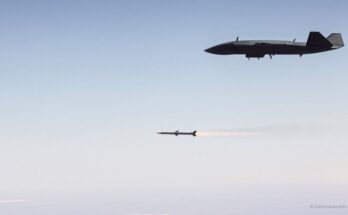by Larry Dickerson, Missile Systems Analyst, Forecast International.
The Lockheed Martin precision-guided Joint Air-to-Surface Missile (JASSM) made its official combat debut in 2018 during an attack on Syrian chemical warfare facilities.
In the past, unguided bombs were the primary weapon used by tactical fighters and strategic bombers. Thousands were needed to destroy a target since few could be actually relied on to hit it. This changed with the introduction of precision-guided munitions.
Today, a single mission using PGMs can destroy a target that, in the past, had required hundreds of unguided bombs and multiple attempts to demolish. Lockheed Martin is among the companies attempting to grab a commanding position within this market. One system helping the company reach this goal is the JASSM.
The U.S. Air Force is moving ahead with plans to procure about 5,000 JASSMs and JASSM-ERs. More JASSM-ERs will be acquired than previously thought, but fewer baseline versions.
The introduction of new models incorporating different payloads and offering greater range will help support U.S. procurement through the next decade.
Lockheed Martin sees a considerable export potential for the JASSM series. Anywhere from 1,200 to 3,800 missiles may be exported over the life of this program. Australia, Finland, and Poland are already customers for the JASSM, with Japan perhaps following in the near future.
The U.K. could become a customer for this missile once it begins operating the F-35 Lightning II Joint Strike Fighter. Other countries showing interest in the JASSM include Canada, Egypt, Saudi Arabia, Israel, and the United Arab Emirates. A potential obstacle to further exports is a reluctance by the United States to allow them.
In spite of competition from its rivals, such as the SCALP-EG, the JASSM could win a larger number of orders over any of its challengers. U.S. procurement plans appear firm, but delays in the arrival of export orders could cause significant fluctuations in production numbers.
For 50 years, Forecast International intelligence reports have been the aerospace and defense industry standard for accurate research, analysis, and projections. Our experienced analysts compile, evaluate, and present accurate data for decision makers. FI's market research reports offer concise analysis of individual programs and identify market opportunities. Each report includes a program overview, detailed statistics, recent developments and a competitive analysis, culminating in production forecasts spanning 10 or 15 years. Let our market intelligence reports be a key part of reducing uncertainties and mastering your specific market and its growth potential. Find out more at www.forecastinternational.com



